trailer Lancia Thema 2013 Owner handbook (in English)
[x] Cancel search | Manufacturer: LANCIA, Model Year: 2013, Model line: Thema, Model: Lancia Thema 2013Pages: 336, PDF Size: 3.87 MB
Page 76 of 336
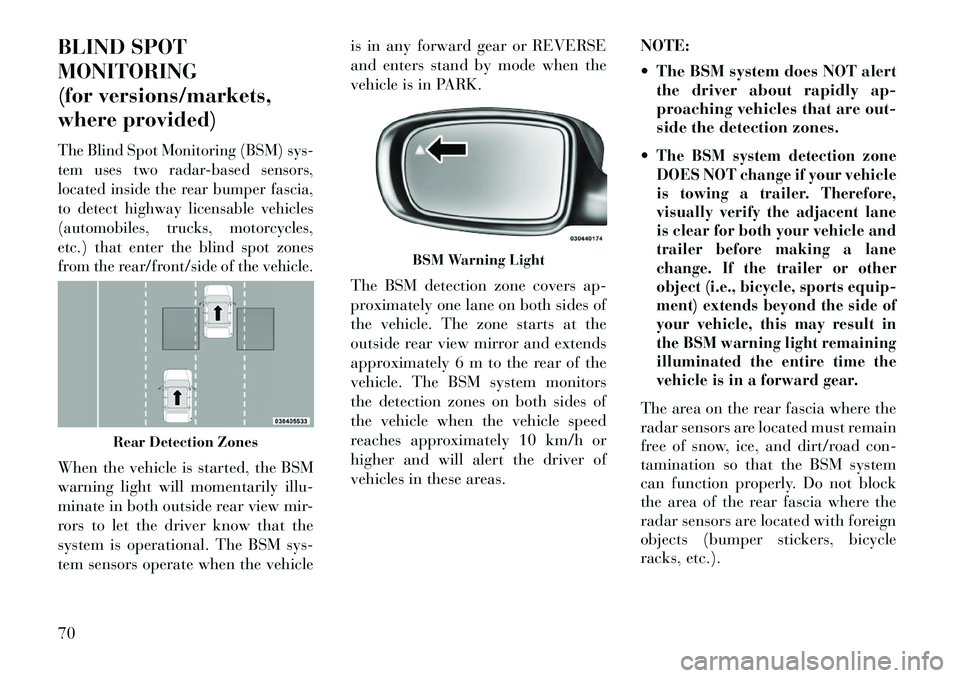
BLIND SPOT
MONITORING
(for versions/markets,
where provided)The Blind Spot Monitoring (BSM) sys-
tem uses two radar-based sensors,
located inside the rear bumper fascia,
to detect highway licensable vehicles
(automobiles, trucks, motorcycles,
etc.) that enter the blind spot zones
from the rear/front/side of the vehicle.When the vehicle is started, the BSM
warning light will momentarily illu-
minate in both outside rear view mir-
rors to let the driver know that the
system is operational. The BSM sys-
tem sensors operate when the vehicleis in any forward gear or REVERSE
and enters stand by mode when the
vehicle is in PARK.
The BSM detection zone covers ap-
proximately one lane on both sides of
the vehicle. The zone starts at the
outside rear view mirror and extends
approximately 6 m to the rear of the
vehicle. The BSM system monitors
the detection zones on both sides of
the vehicle when the vehicle speed
reaches approximately 10 km/h or
higher and will alert the driver of
vehicles in these areas.
NOTE:
The BSM system does NOT alert
the driver about rapidly ap-
proaching vehicles that are out-
side the detection zones.
The BSM system detection zone
DOES NOT change if your vehicle
is towing a trailer. Therefore,
visually verify the adjacent lane
is clear for both your vehicle and
trailer before making a lane
change. If the trailer or other
object (i.e., bicycle, sports equip-
ment) extends beyond the side of
your vehicle, this may result in
the BSM warning light remaining
illuminated the entire time the
vehicle is in a forward gear.The area on the rear fascia where the
radar sensors are located must remain
free of snow, ice, and dirt/road con-
tamination so that the BSM system
can function properly. Do not block
the area of the rear fascia where the
radar sensors are located with foreign
objects (bumper stickers, bicycle
racks, etc.).
Rear Detection Zones
BSM Warning Light
70
Page 128 of 336
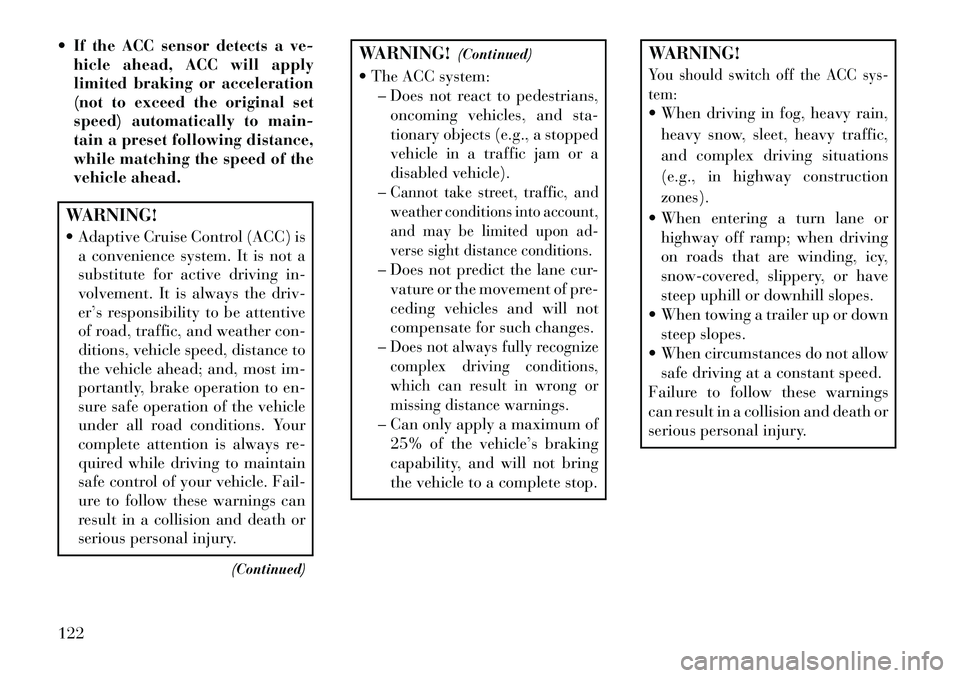
If the ACC sensor detects a ve-hicle ahead, ACC will apply
limited braking or acceleration
(not to exceed the original set
speed) automatically to main-
tain a preset following distance,
while matching the speed of the
vehicle ahead.WARNING!
Adaptive Cruise Control (ACC) isa convenience system. It is not a
substitute for active driving in-
volvement. It is always the driv-
er’s responsibility to be attentive
of road, traffic, and weather con-
ditions, vehicle speed, distance to
the vehicle ahead; and, most im-
portantly, brake operation to en-
sure safe operation of the vehicle
under all road conditions. Your
complete attention is always re-
quired while driving to maintain
safe control of your vehicle. Fail-
ure to follow these warnings can
result in a collision and death or
serious personal injury.
(Continued)
WARNING!(Continued)
The ACC system: – Does not react to pedestrians,oncoming vehicles, and sta-
tionary objects (e.g., a stopped
vehicle in a traffic jam or a
disabled vehicle).
–
Cannot take street, traffic, and
weather conditions into account,
and may be limited upon ad-
verse sight distance conditions.– Does not predict the lane cur- vature or the movement of pre-
ceding vehicles and will not
compensate for such changes.
–Does not always fully recognize
complex driving conditions,
which can result in wrong or
missing distance warnings.– Can only apply a maximum of 25% of the vehicle’s braking
capability, and will not bring
the vehicle to a complete stop.
WARNING!You should switch off the ACC sys-
tem: When driving in fog, heavy rain,
heavy snow, sleet, heavy traffic,
and complex driving situations
(e.g., in highway construction
zones).
When entering a turn lane or highway off ramp; when driving
on roads that are winding, icy,
snow-covered, slippery, or have
steep uphill or downhill slopes.
When towing a trailer up or down steep slopes.
When circumstances do not allow safe driving at a constant speed.
Failure to follow these warnings
can result in a collision and death or
serious personal injury.
122
Page 135 of 336

If weather conditions are not a factor,
the driver should examine the sensor.
It may require cleaning or removal of
an obstruction. The sensor is located
in the center of the vehicle behind the
lower grille.
To keep the ACC System operating
properly, it is important to note the
following maintenance items:
Always keep the sensor clean. Care-fully wipe the sensor lens with a soft
cloth. Be cautious not to damage
the sensor lens.
Do not remove any screws from the sensor. Doing so could cause an
ACC system malfunction or failure
and require a sensor realignment.
If the sensor is damaged due to a collision, see your authorized dealer
for service.
Do not attach or install any accesso-
ries near the sensor, including trans-
parent material or aftermarket
grilles. Doing so could cause an ACC
system failure or malfunction.
When the condition that deactivated the
system is no longer present, the system
will return to the “Adaptive Cruise Con-
trol Off” state and will resume function
by simply reactivating it.NOTE: Installing a vehicle front-
end protector or an aftermarket
grille or modifying the grille is not
recommended. Doing so may
block the sensor and inhibit ACC
operation.
ACC Unavailable Warning
If the system turns off, and the EVIC
displays “Adaptive Cruise Control
(ACC) Unavailable”, there may be a
temporary malfunction that limits
ACC functionality. Although the ve-
hicle is still drivable under normal
conditions, ACC will be temporarily
unavailable. If this occurs, try activat-
ing ACC again later, following a key
cycle. If the problem persists, see your
authorized dealer. PRECAUTIONS WHILE
DRIVING WITH ACC
In certain driving situations, ACC
may have detection issues. In these
cases, ACC may brake late or unex-
pectedly. The driver needs to stay
alert and may need to intervene.
Adding A Trailer Hitch
The weight of a trailer/hitch may af-
fect the performance of ACC. If there
is a noticeable change in performance
following the installation of a trailer/
hitch, or if the ACC performance does
not return to normal after removing
the trailer/hitch see your authorized
dealer.
Adaptive Cruise Control (ACC)
Unavailable Warning
129
Page 143 of 336
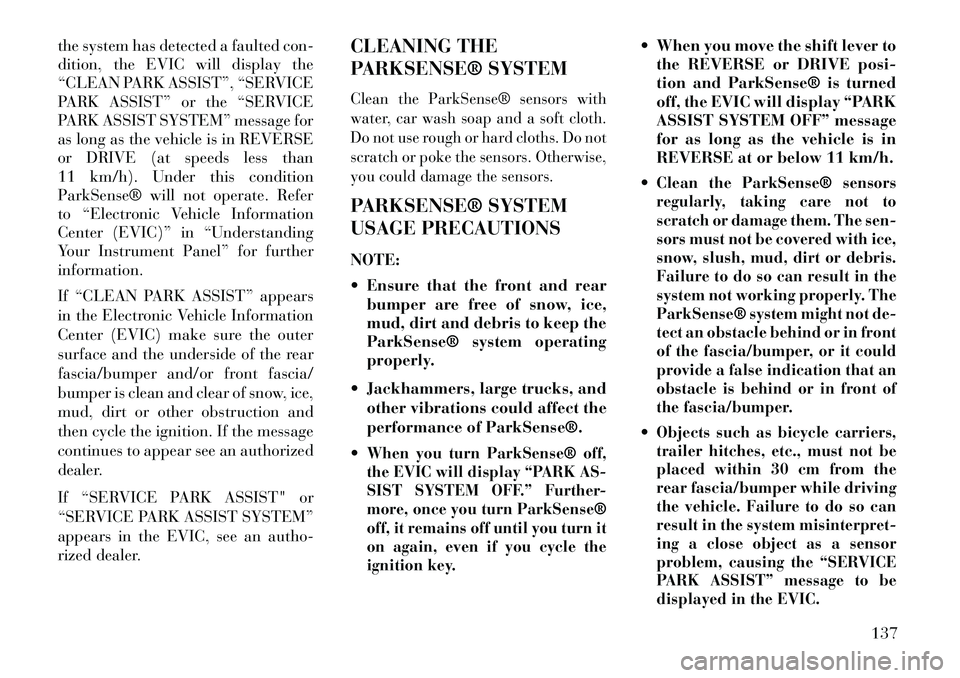
the system has detected a faulted con-
dition, the EVIC will display the
“CLEAN PARK ASSIST”, “SERVICE
PARK ASSIST” or the “SERVICE
PARK ASSIST SYSTEM” message for
as long as the vehicle is in REVERSE
or DRIVE (at speeds less than
11 km/h). Under this condition
ParkSense® will not operate. Refer
to “Electronic Vehicle Information
Center (EVIC)” in “Understanding
Your Instrument Panel” for further
information.
If “CLEAN PARK ASSIST” appears
in the Electronic Vehicle Information
Center (EVIC) make sure the outer
surface and the underside of the rear
fascia/bumper and/or front fascia/
bumper is clean and clear of snow, ice,
mud, dirt or other obstruction and
then cycle the ignition. If the message
continues to appear see an authorized
dealer.
If “SERVICE PARK ASSIST" or
“SERVICE PARK ASSIST SYSTEM”
appears in the EVIC, see an autho-
rized dealer.CLEANING THE
PARKSENSE® SYSTEM
Clean the ParkSense® sensors with
water, car wash soap and a soft cloth.
Do not use rough or hard cloths. Do not
scratch or poke the sensors. Otherwise,
you could damage the sensors.PARKSENSE® SYSTEM
USAGE PRECAUTIONS
NOTE:
Ensure that the front and rear
bumper are free of snow, ice,
mud, dirt and debris to keep the
ParkSense® system operating
properly.
Jackhammers, large trucks, and other vibrations could affect the
performance of ParkSense®.
When you turn ParkSense® off,
the EVIC will display “PARK AS-
SIST SYSTEM OFF.” Further-
more, once you turn ParkSense®
off, it remains off until you turn it
on again, even if you cycle the
ignition key.
When you move the shift lever to the REVERSE or DRIVE posi-
tion and ParkSense® is turned
off, the EVIC will display “PARK
ASSIST SYSTEM OFF” message
for as long as the vehicle is in
REVERSE at or below 11 km/h.
Clean the ParkSense® sensors
regularly, taking care not to
scratch or damage them. The sen-
sors must not be covered with ice,
snow, slush, mud, dirt or debris.
Failure to do so can result in the
system not working properly. The
ParkSense® system might not de-
tect an obstacle behind or in front
of the fascia/bumper, or it could
provide a false indication that an
obstacle is behind or in front of
the fascia/bumper.Objects such as bicycle carriers,
trailer hitches, etc., must not be
placed within 30 cm from the
rear fascia/bumper while driving
the vehicle. Failure to do so can
result in the system misinterpret-
ing a close object as a sensor
problem, causing the “SERVICE
PARK ASSIST” message to be
displayed in the EVIC.
137
Page 168 of 336
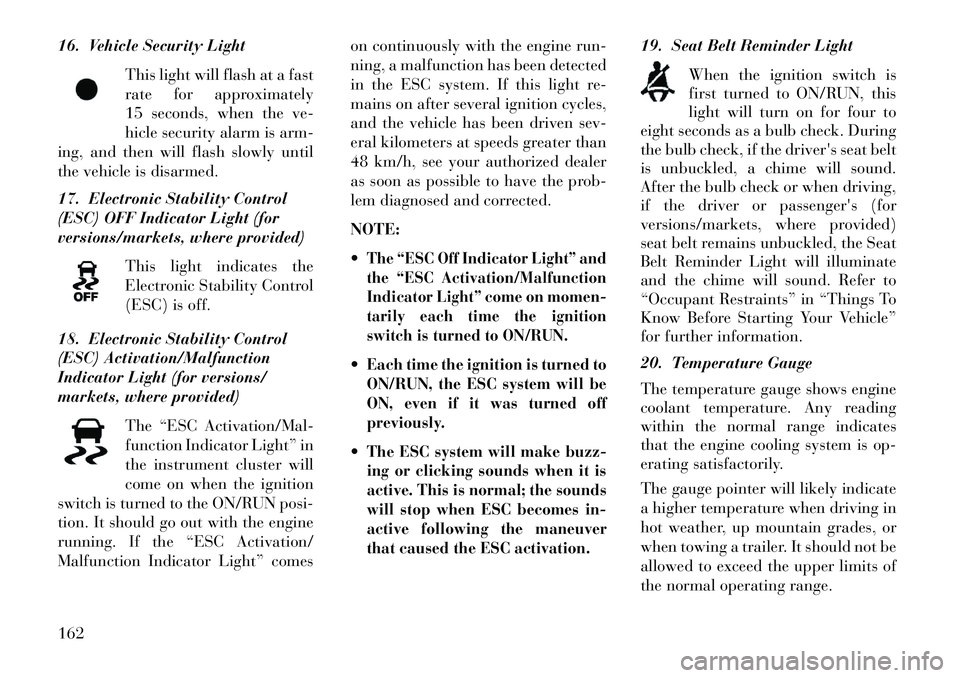
16. Vehicle Security LightThis light will flash at a fast
rate for approximately
15 seconds, when the ve-
hicle security alarm is arm-
ing, and then will flash slowly until
the vehicle is disarmed.
17. Electronic Stability Control
(ESC) OFF Indicator Light (for
versions/markets, where provided)
This light indicates the
Electronic Stability Control
(ESC) is off.
18. Electronic Stability Control
(ESC) Activation/Malfunction
Indicator Light (for versions/
markets, where provided) The “ESC Activation/Mal-
function Indicator Light” in
the instrument cluster will
come on when the ignition
switch is turned to the ON/RUN posi-
tion. It should go out with the engine
running. If the “ESC Activation/
Malfunction Indicator Light” comes on continuously with the engine run-
ning, a malfunction has been detected
in the ESC system. If this light re-
mains on after several ignition cycles,
and the vehicle has been driven sev-
eral kilometers at speeds greater than
48 km/h, see your authorized dealer
as soon as possible to have the prob-
lem diagnosed and corrected.
NOTE:
The “ESC Off Indicator Light” and
the “ESC Activation/Malfunction
Indicator Light” come on momen-
tarily each time the ignition
switch is turned to ON/RUN.Each time the ignition is turned to
ON/RUN, the ESC system will be
ON, even if it was turned off
previously.The ESC system will make buzz-
ing or clicking sounds when it is
active. This is normal; the sounds
will stop when ESC becomes in-
active following the maneuver
that caused the ESC activation.
19. Seat Belt Reminder Light
When the ignition switch is
first turned to ON/RUN, this
light will turn on for four to
eight seconds as a bulb check. During
the bulb check, if the driver's seat belt
is unbuckled, a chime will sound.
After the bulb check or when driving,
if the driver or passenger's (for
versions/markets, where provided)
seat belt remains unbuckled, the Seat
Belt Reminder Light will illuminate
and the chime will sound. Refer to
“Occupant Restraints” in “Things To
Know Before Starting Your Vehicle”
for further information.
20. Temperature Gauge
The temperature gauge shows engine
coolant temperature. Any reading
within the normal range indicates
that the engine cooling system is op-
erating satisfactorily.
The gauge pointer will likely indicate
a higher temperature when driving in
hot weather, up mountain grades, or
when towing a trailer. It should not be
allowed to exceed the upper limits of
the normal operating range.
162
Page 174 of 336

continuously flash and a continuous
chime will occur until the engine is
allowed to cool.
If the telltale turns on while driving,
safely pull over and stop the vehicle. If
the A/C system is on, turn it off. Also,
shift the transmission into NEUTRAL
and idle the vehicle. If the tempera-
ture reading does not return to nor-
mal, turn the engine off immediately
and call for service. Refer to “If Your
Engine Overheats” in “What To Do In
Emergencies” for more information.
Transmission Temperature
Warning Telltale
This telltale indicates that
the transmission fluid tem-
perature is running hot. This
may occur with severe usage,
such as trailer towing. If this telltale
turns on, safely pull over and stop the
vehicle. Then, shift the transmission
into PARK and run the engine at idle or
faster until the light turns off.
CAUTION!
Continuous driving with the Trans-
mission Temperature Warning Tell-
tale illuminated will eventually
cause severe transmission damage
or transmission failure.WARNING!
If the Transmission Temperature
Warning Telltale is illuminated and
you continue operating the vehicle,
in some circumstances you could
cause the fluid to boil over, come in
contact with hot engine or exhaust
components and cause a fire.
Electric Power Steering
Malfunction This telltale is on when the
Electric Power Steering is
not operating and needs
service. OIL CHANGE DUE
Your vehicle is equipped with an en-
gine oil change indicator system. The
“Oil Change Due” message will flash
in the EVIC display for approxi-
mately 10 seconds after a single chime
has sounded to indicate the next
scheduled oil change interval. The en-
gine oil change indicator system is
duty cycle based, which means the
engine oil change interval may fluctu-
ate dependent upon your personal
driving style.
Unless reset, this message will con-
tinue to display each time you cycle the
ignition to the ON/RUN position. To
turn off the message temporarily, press
and release the BACK button. To reset
the oil change indicator system please
refer to a Lancia Dealership.
168
Page 200 of 336
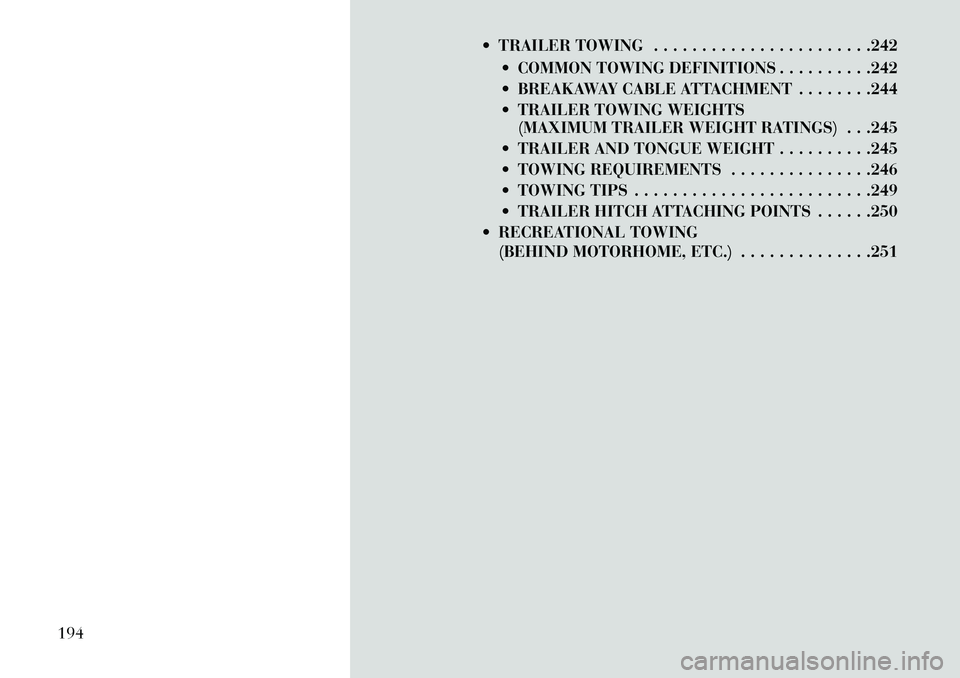
TRAILER TOWING . . . . . . . . . . . . . . . . . . . . . . .242 COMMON TOWING DEFINITIONS . . . . . . . . . .242
BREAKAWAY CABLE ATTACHMENT . . . . . . . .244
TRAILER TOWING WEIGHTS(MAXIMUM TRAILER WEIGHT RATINGS) . . .245
TRAILER AND TONGUE WEIGHT . . . . . . . . . .245
TOWING REQUIREMENTS . . . . . . . . . . . . . . .246
TOWING TIPS . . . . . . . . . . . . . . . . . . . . . . . . .249
TRAILER HITCH ATTACHING POINTS . . . . . .250
RECREATIONAL TOWING (BEHIND MOTORHOME, ETC.) . . . . . . . . . . . . . .251
194
Page 209 of 336

CAUTION!
Towing the vehicle, coasting, or
driving for any other reason with
the transmission in NEUTRAL can
cause severe transmission damage.
Refer to “Recreational Towing” in
“Starting And Operating” and
“Towing A Disabled Vehicle” in
“What To Do In Emergencies” for
further information.
DRIVE
This range should be used for most
city and highway driving. It provides
the smoothest upshifts and down-
shifts, and the best fuel economy. The
transmission automatically upshifts
through all forward gears. The
DRIVE position provides optimum
driving characteristics under all nor-
mal operating conditions.
When frequent transmission shifting
occurs (such as when operating the
vehicle under heavy loading condi-
tions, in hilly terrain, traveling into
strong head winds, or while towing heavy trailers), use the AutoStick®
shift control (if equipped) to select a
lower gear. Under these conditions,
using a lower gear will improve per-
formance and extend transmission life
by reducing excessive shifting and
heat buildup.
During extremely cold temperatures
(30°C or below), transmission op-
eration may be modified depending
on engine and transmission tempera-
ture as well as vehicle speed. Normal
operation will resume once the trans-
mission temperature has risen to a
suitable level.
SPORT (for versions/markets,
where provided)
This mode alters the transmission's
automatic shift schedule for sportier
driving. Upshift speeds are increased
to make full use of available engine
power. To switch between DRIVE and
SPORT modes, tap the shift lever
rearward. SPORT mode is only acces-
sible from DRIVE.
LOW
Use this range for engine braking
when descending very steep grades. In
this range, the transmission will
downshift for increased engine brak-
ing. To switch between DRIVE and
LOW modes, tap the shift lever rear-
ward. LOW mode is only accessible
from DRIVE.
Transmission Limp Home Mode
Transmission function is monitored
electronically for abnormal condi-
tions. If a condition is detected that
could result in transmission damage,
Transmission Limp Home Mode is ac-
tivated. In this mode, the transmis-
sion may operate only in certain
gears, or may not shift at all. Vehicle
performance may be severely de-
graded and the engine may stall. In
some situations, the transmission may
not re-engage if the engine is turned
off and restarted. The Malfunction In-
dicator Light (MIL) may be illumi-
nated. A message in the instrument
cluster will inform the driver of the
more serious conditions, and indicate
what actions may be necessary.
203
Page 213 of 336

DRIVE
This range should be used for most
city and highway driving. It provides
the smoothest upshifts and down-
shifts, and the best fuel economy. The
transmission automatically upshifts
through underdrive first, second, and
third gears, direct fourth gear and
overdrive fifth gear. The DRIVE posi-
tion provides optimum driving char-
acteristics under all normal operating
conditions.When frequent transmission shifting
occurs (such as when operating the ve-
hicle under heavy loading conditions,
in hilly terrain, traveling into strong
head winds, or while towing heavy
trailers), use the “AutoStick®” shift
control (for versions/markets, where
provided; refer to “AutoStick®” in this
section) to select a lower gear. Under
these conditions, using a lower gear
will improve performance and extend
transmission life by reducing excessive
shifting and heat buildup.
Transmission Limp Home ModeTransmission function is monitored
electronically for abnormal conditions.
If a condition is detected that could
result in transmission damage, Trans-
mission Limp Home Mode is activated.
In this mode, the transmission remains
in the current gear until the vehicle is
brought to a stop. After the vehicle has
stopped, the transmission will remain
in second gear regardless of which for-
ward gear is selected. PARK, RE-
VERSE, and NEUTRAL will continue
to operate. The Malfunction Indicator
Light (MIL) may be illuminated. Limp
Home Mode allows the vehicle to be
driven to an authorized dealer for
service without damaging the trans-
mission.In the event of a momentary problem,
the transmission can be reset to regain
all forward gears by performing the
following steps:
1. Stop the vehicle.
2. Shift the transmission into PARK.
3. Turn the engine OFF.
4.
Wait approximately 10 seconds.
5. Restart the engine.
6.
Shift into the desired gear range.
If the problem is no longer detected, the
transmission will return to normal op-
eration.
NOTE:
Even if the transmission
can be reset, we recommend that
you visit your authorized dealer at
your earliest possible convenience.
Your authorized dealer has diag-
nostic equipment to determine if
the problem could recur. If the
transmission cannot be reset, au-
thorized dealer service is required.
Overdrive Operation
The automatic transmission includes
an electronically controlled Overdrive
(fifth gear). The transmission will au-
tomatically shift into Overdrive if the
following conditions are present:
the shift lever is in the DRIVE po- sition,
vehicle speed is sufficiently high, and
the driver is not heavily pressing the accelerator.
207
Page 214 of 336

AUTOSTICK®
(for versions/markets,
where provided)AutoStick® is a driver-interactive
transmission feature providing manual
shift control, giving you more control of
the vehicle. AutoStick® allows you to
maximize engine braking, eliminate un-
desirable upshifts and downshifts, and
improve overall vehicle performance.This system can also provide you with
more control during passing, city driv-
ing, cold slippery conditions, mountain
driving, trailer towing, and many other
situations.OPERATION – 3.6L ENGINEWhen the transmission is in DRIVE or
SPORT mode, it will operate automati-
cally, shifting between the eight avail-
able gears. To engage AutoStick® (for
versions/markets, where provided),
simply tap one of the steering wheel-
mounted shift paddles (+/-) while in
DRIVE or SPORT mode (for versions/markets, where provided). Tapping (-)
to enter AutoStick® mode will down-
shift the transmission to the next lower
gear, while using (+) to enter
AutoStick® mode will retain the cur-
rent gear. When AutoStick® is active,
the current transmission gear is dis-
played in the instrument cluster. In
AutoStick® mode, the transmission
will only shift up or down when (+/-) is
manually selected by the driver, unless
an engine lugging or overspeed condi-
tion would result. It will remain in the
selected gear until another upshift or
downshift is chosen, except as de-
scribed below.
If AutoStick® is engaged while in
DRIVE mode, the transmission will
automatically shift up when maxi-
mum engine speed is reached. If the
accelerator is fully pressed, the
transmission will downshift when
possible (based on current vehicle
speed and gear). Lack of accelera-
tor pedal activity will cause the
transmission to revert to automatic
operation. If AutoStick® is engaged while in
SPORT mode, manual gear selec-
tion will be maintained until either
SPORT mode is exited or as de-
scribed below. The transmission
will not upshift automatically at
redline in this mode, nor will down-
shifts be obtained if the accelerator
pedal is pressed to the floor.
In either DRIVE or SPORT mode, the transmission will automatically
downshift as the vehicle slows to a
stop (to prevent engine lugging)
and will display the current gear.
Tapping the (+) paddle (at a stop)
will allow starting in second gear.
After a stop, the driver should
manually upshift (+) the transmis-
sion as the vehicle accelerates.
If a requested downshift would cause the engine to over-speed, that
shift will not occur.
The system will ignore attempts to
upshift at too low of a vehicle speed.
208